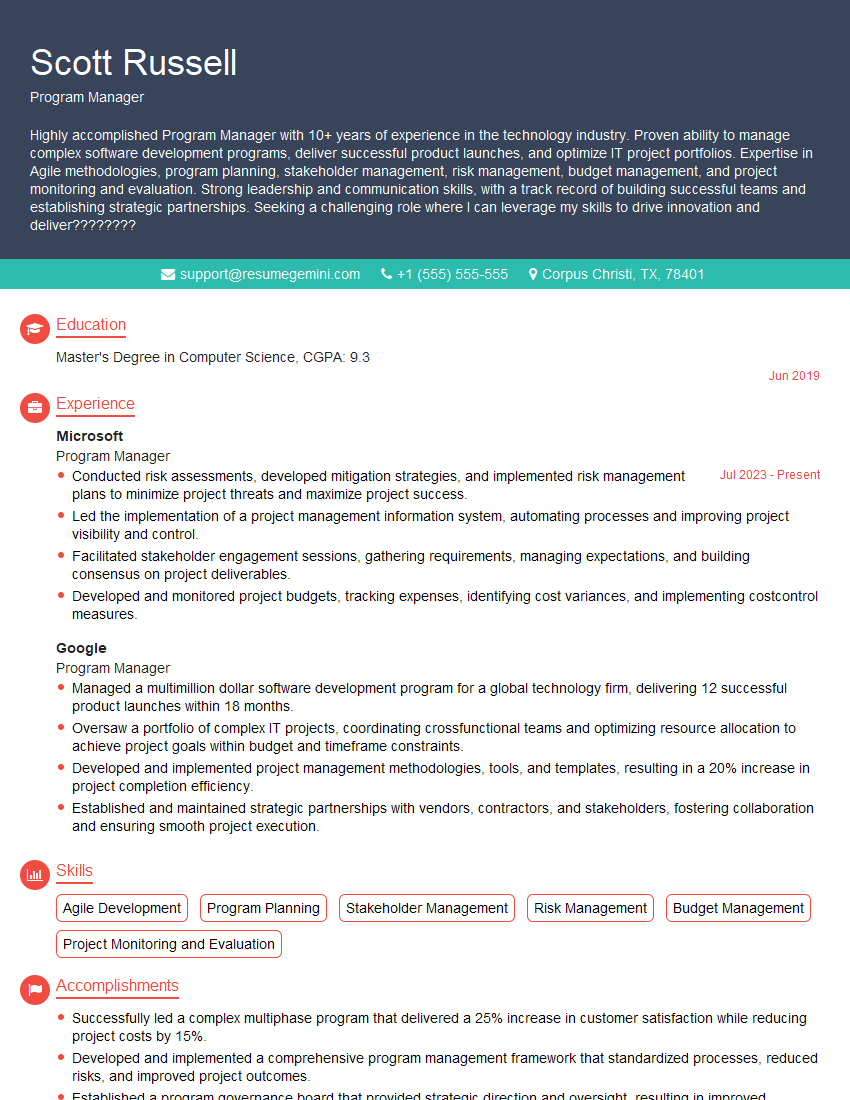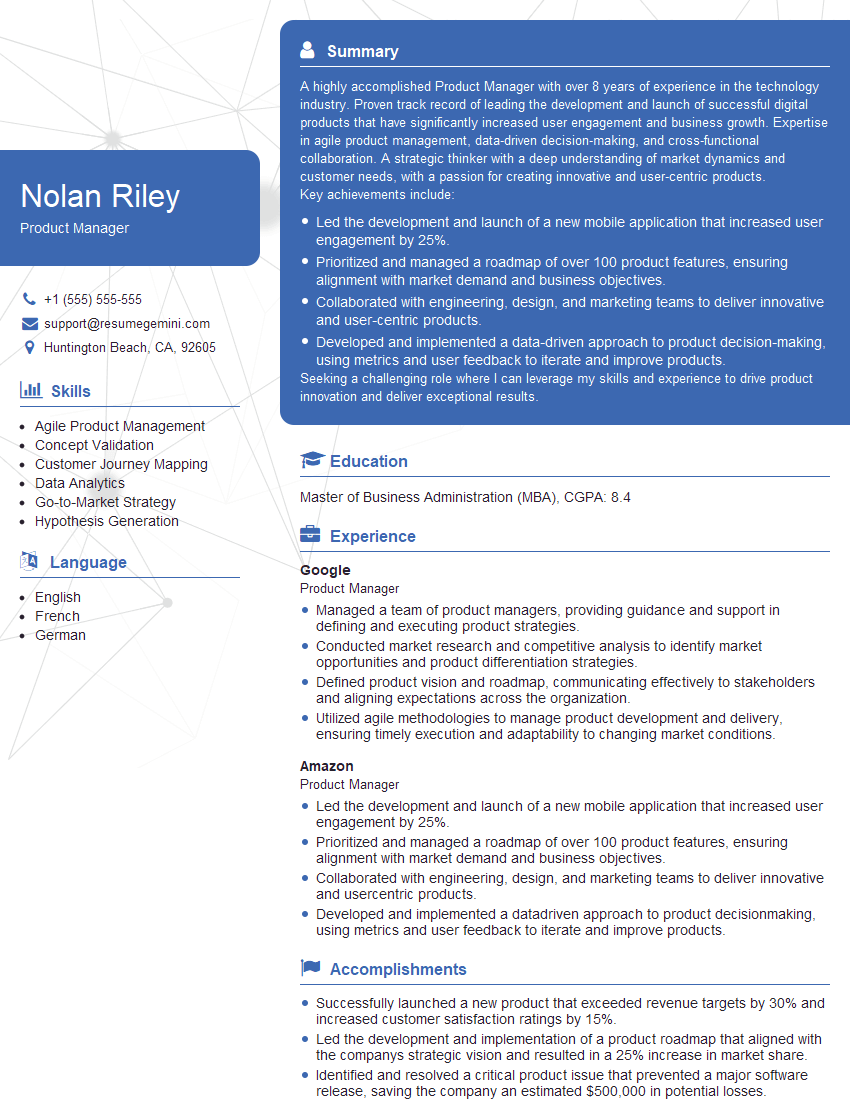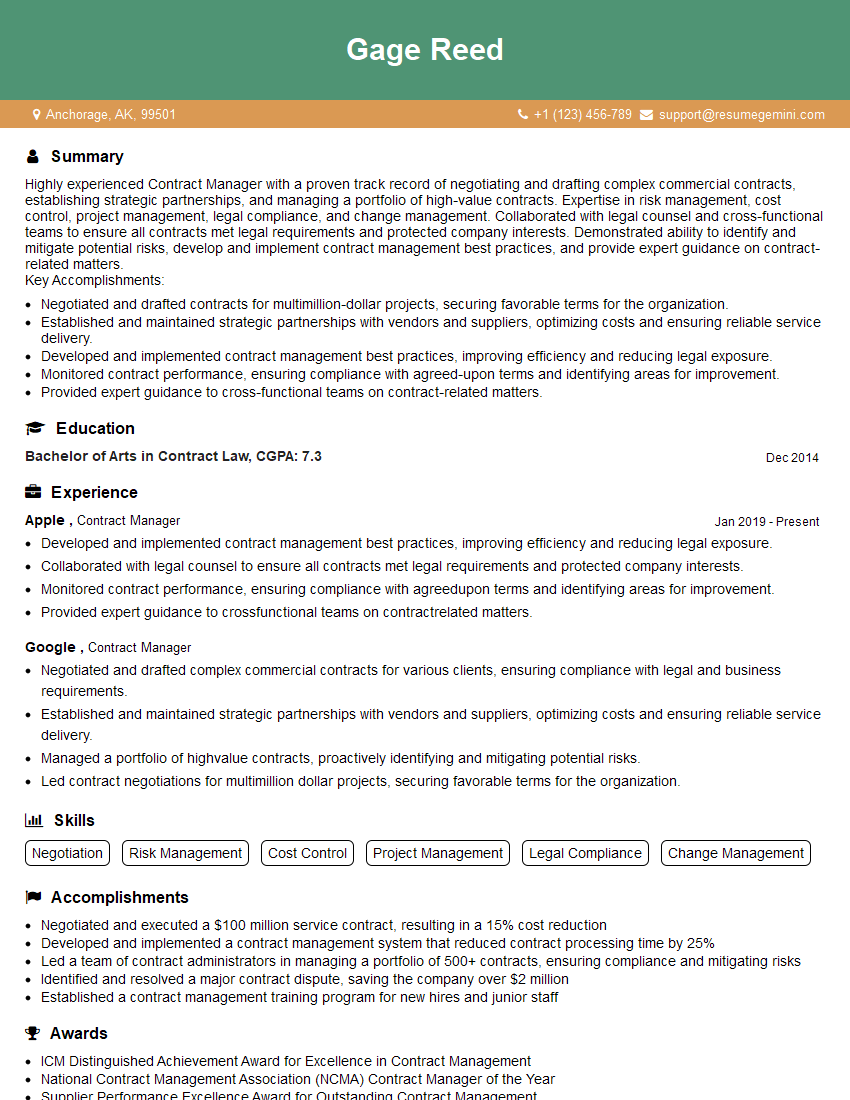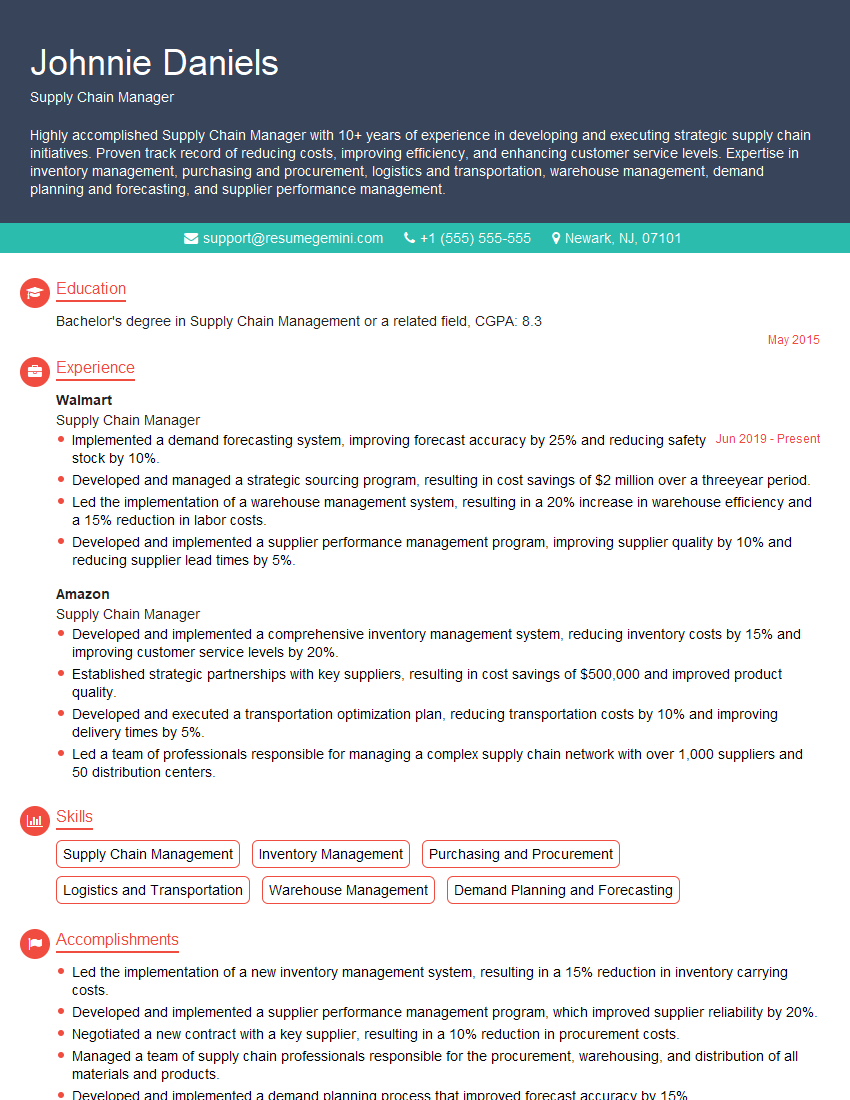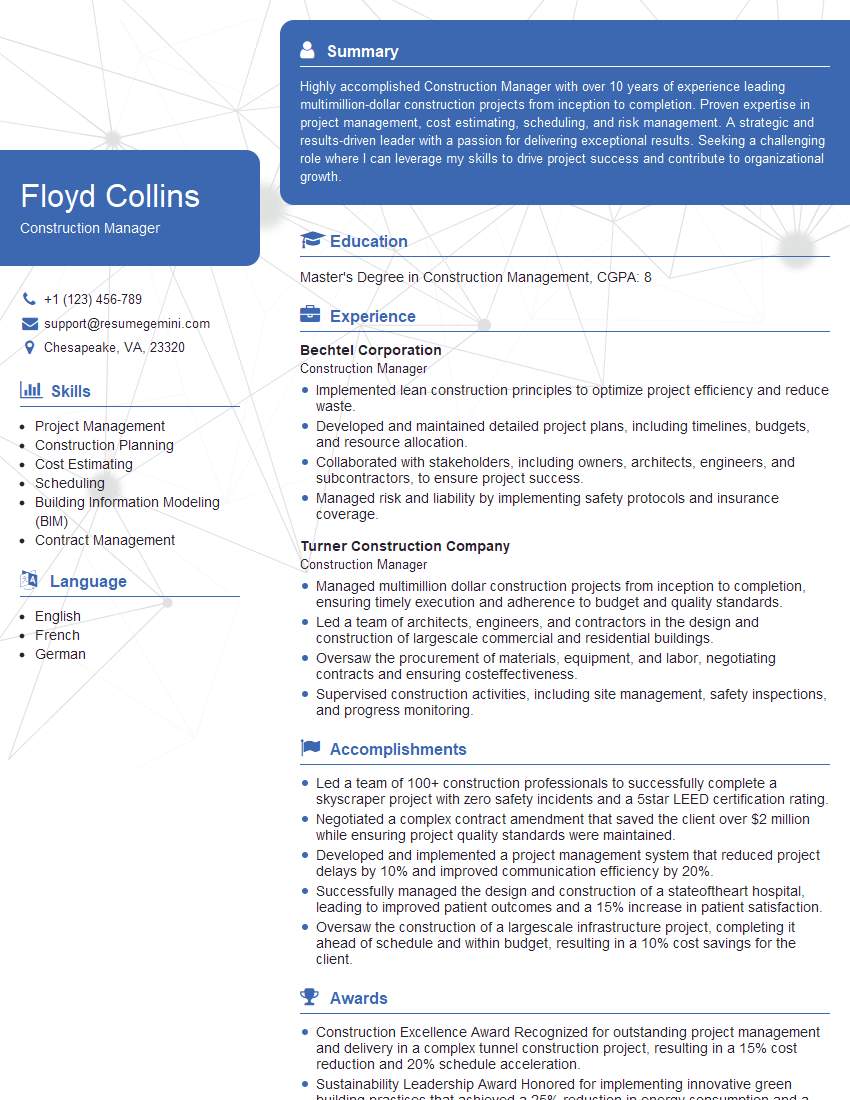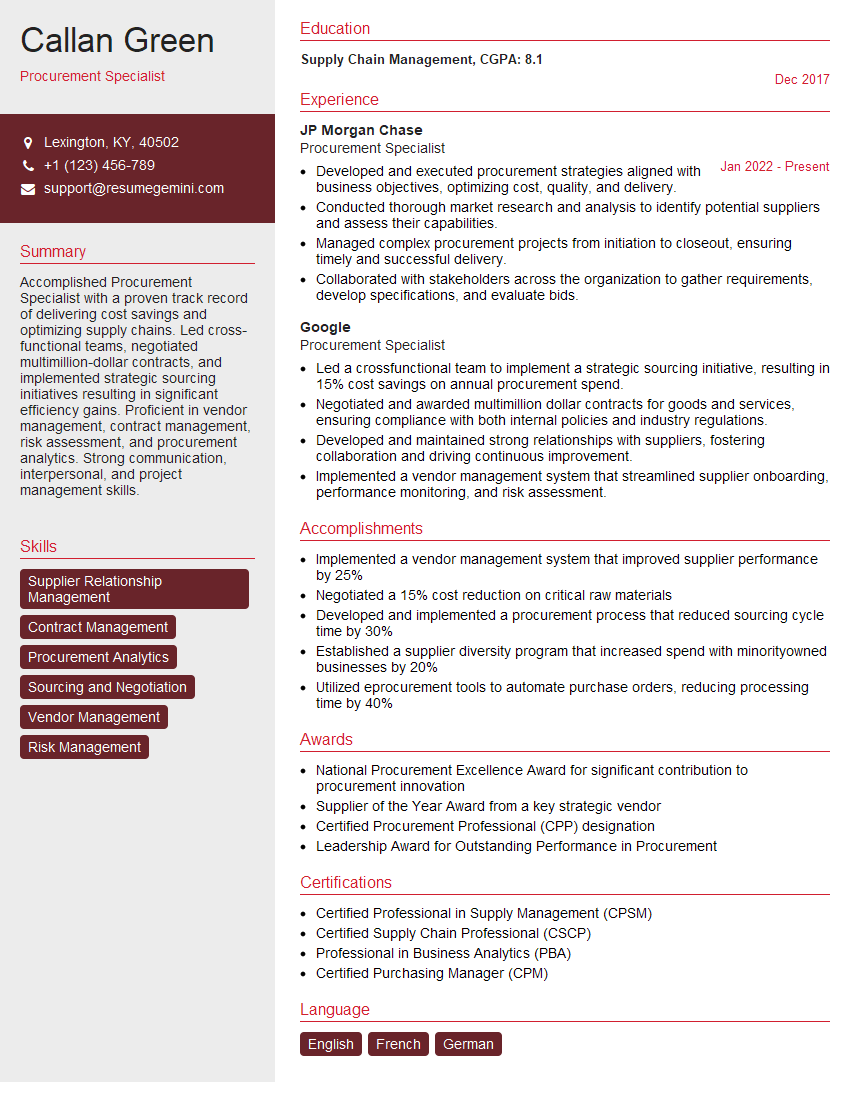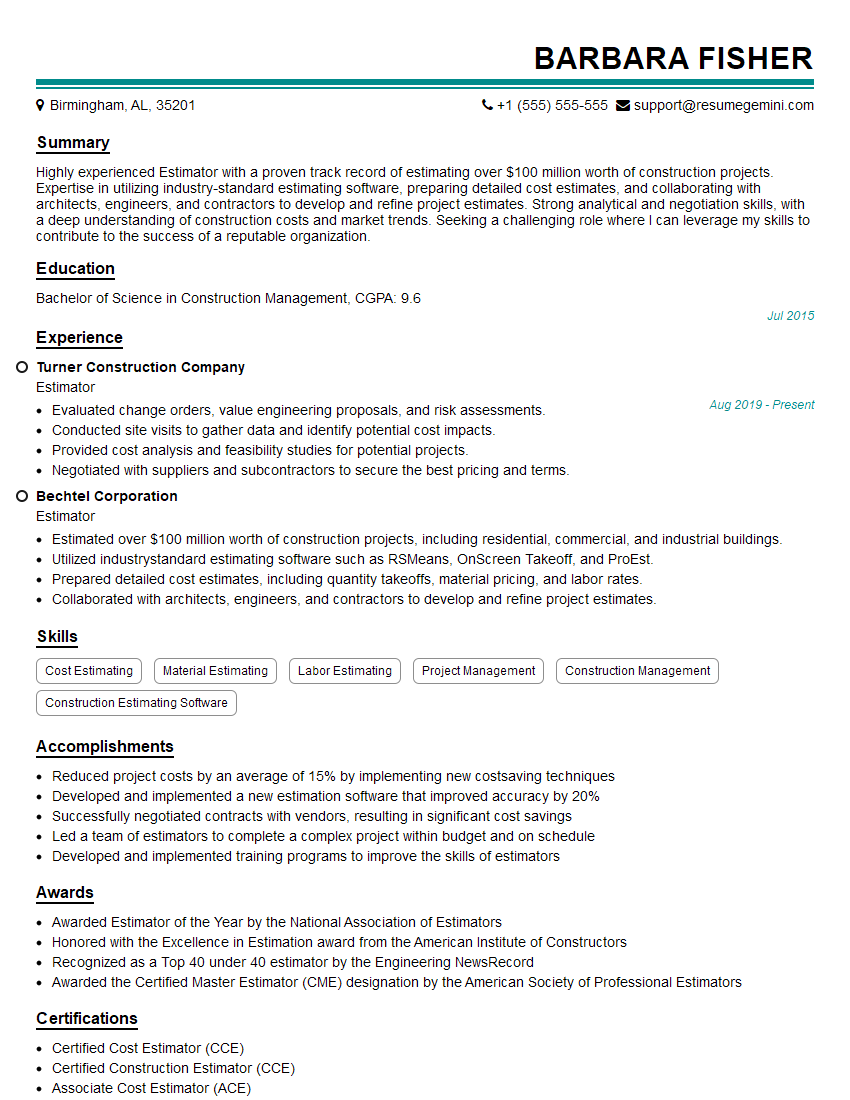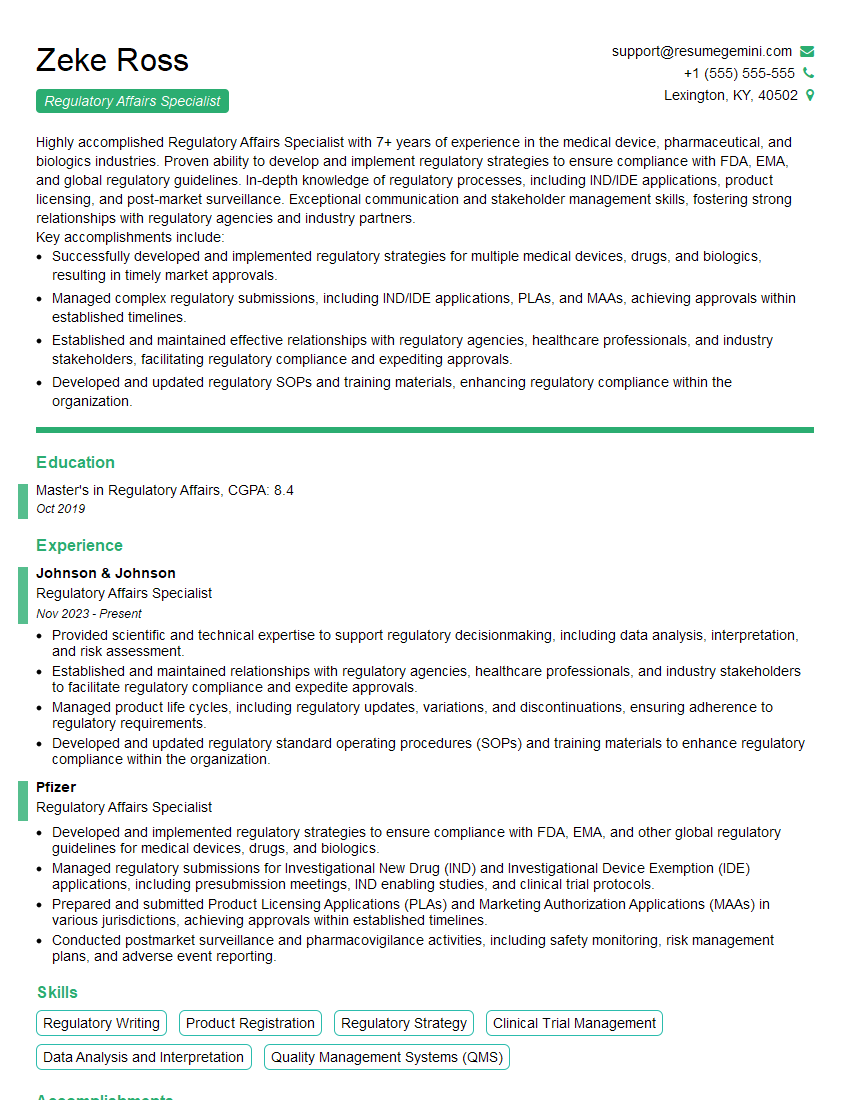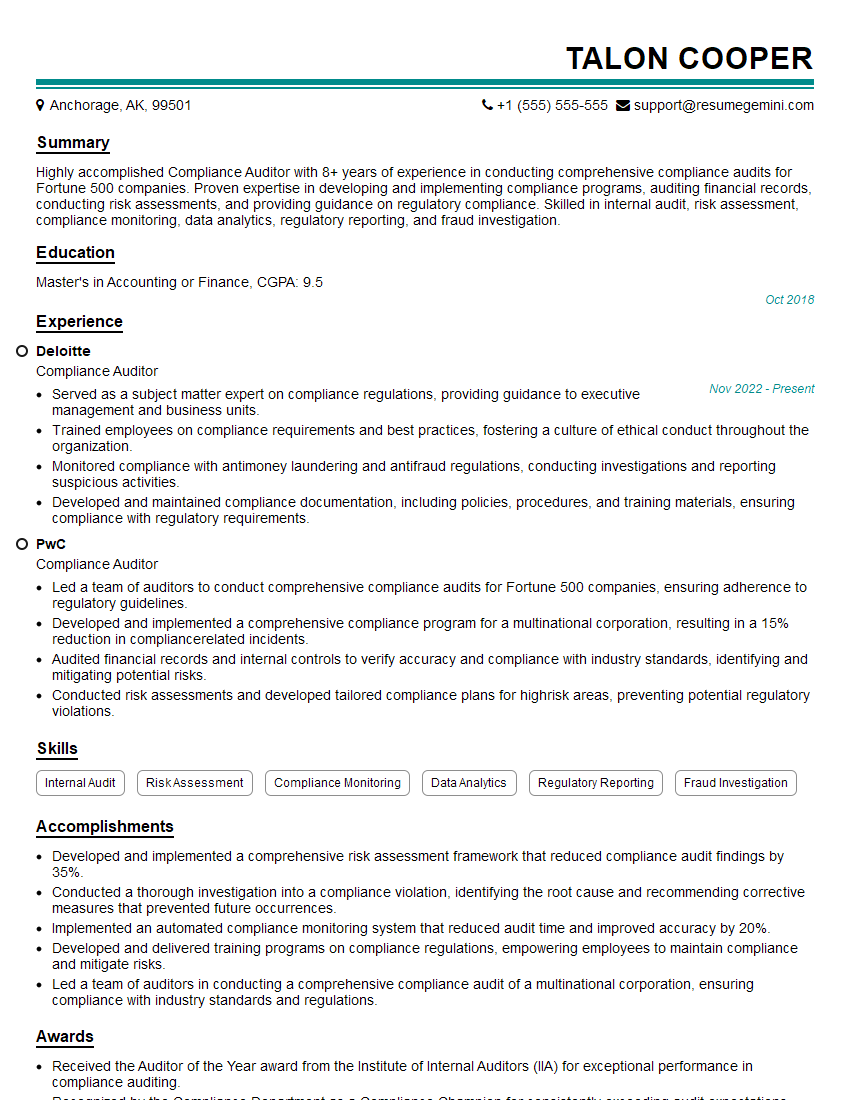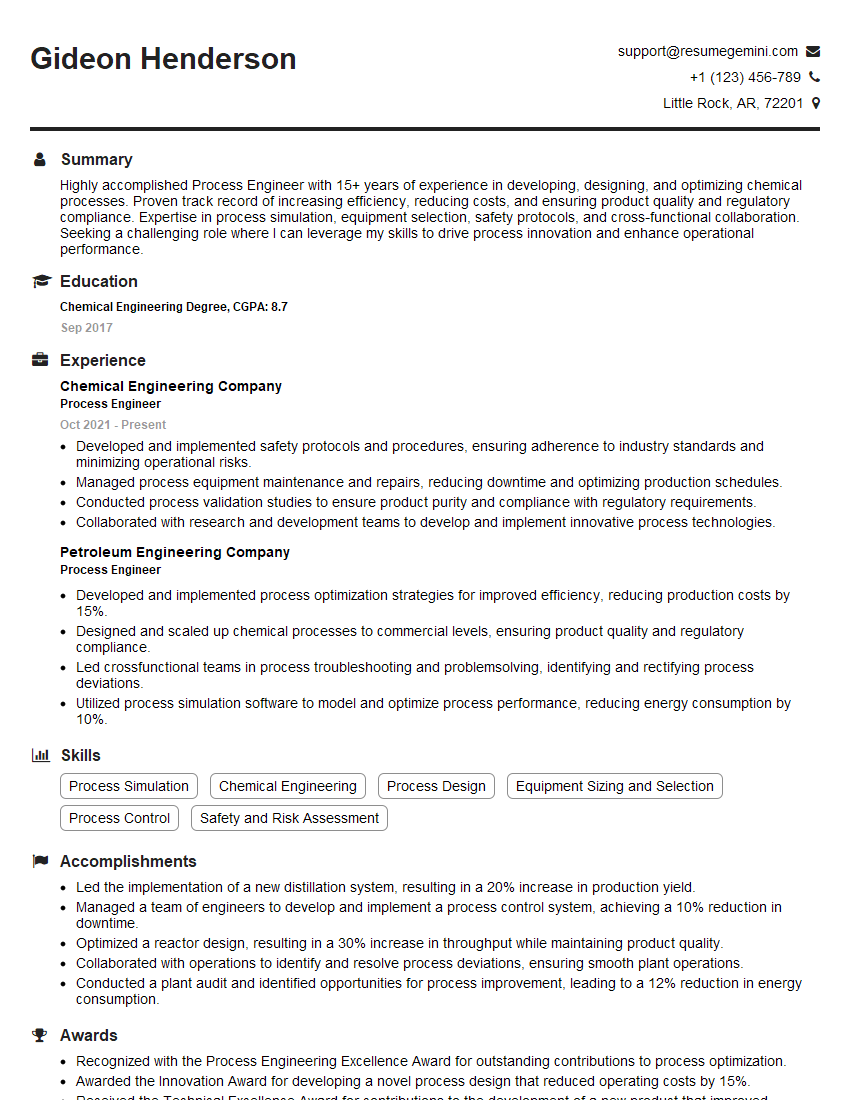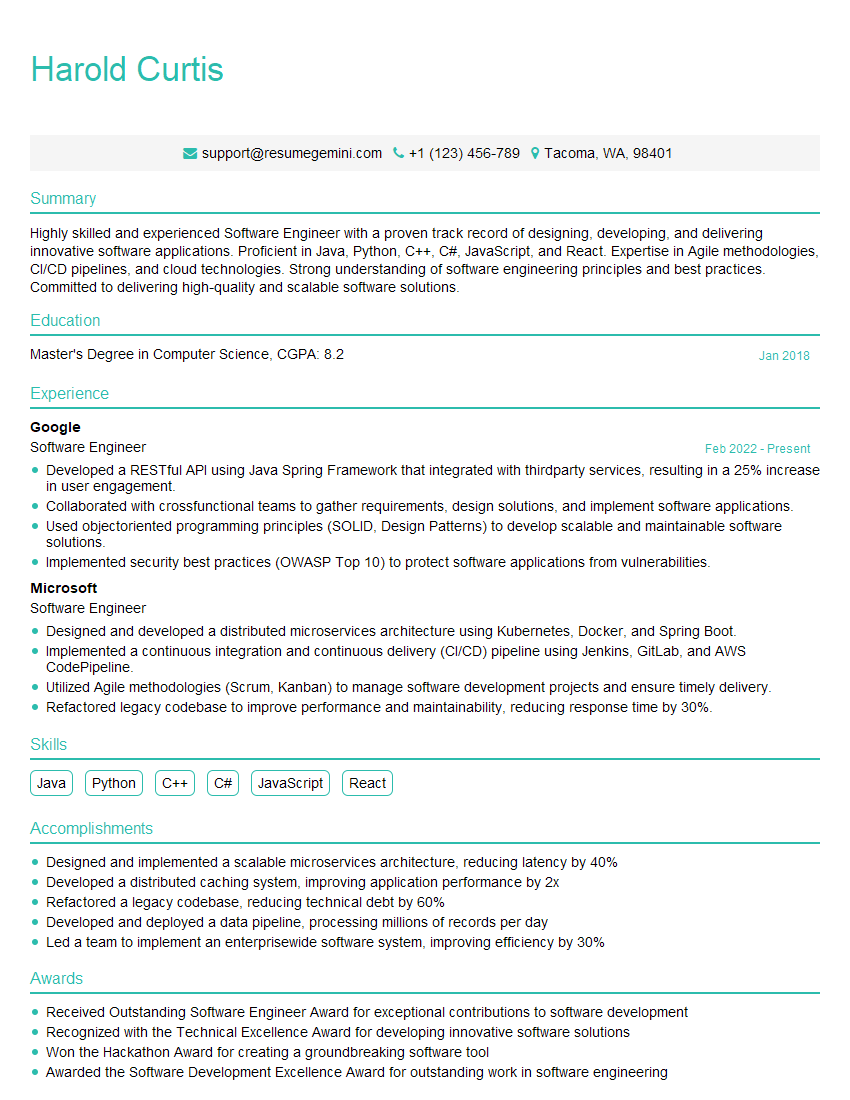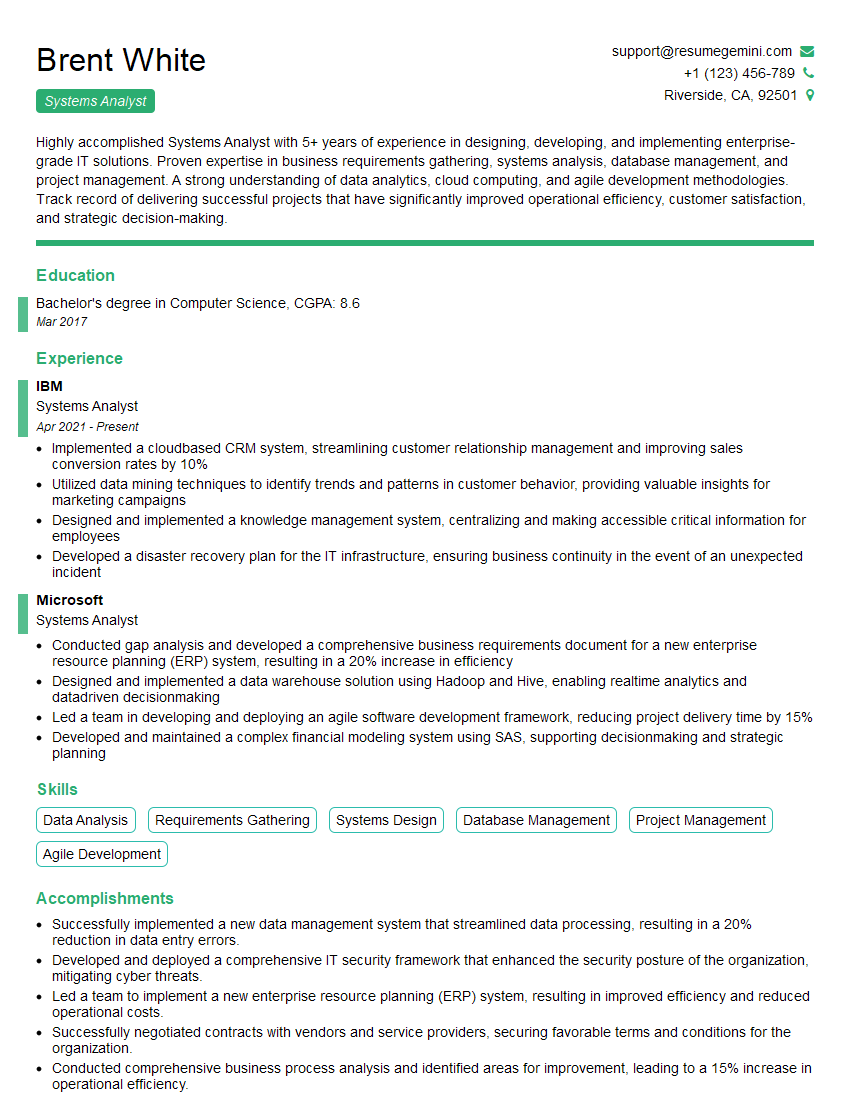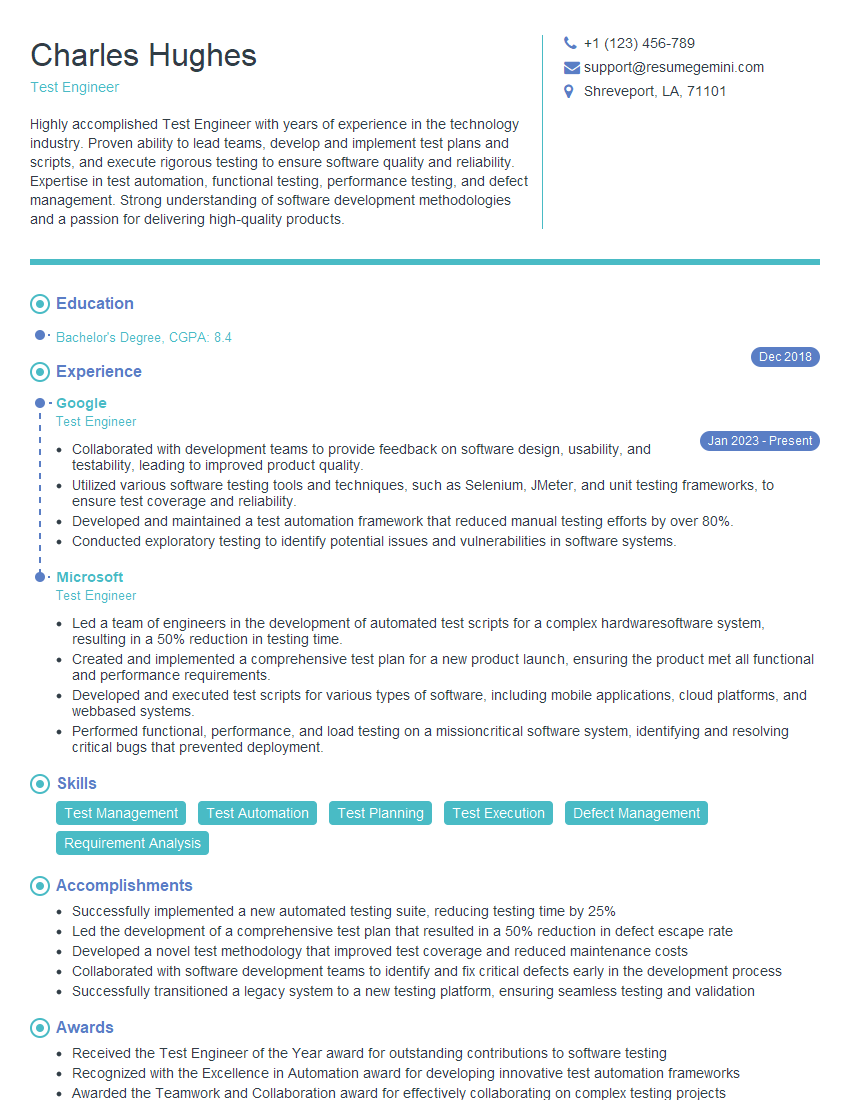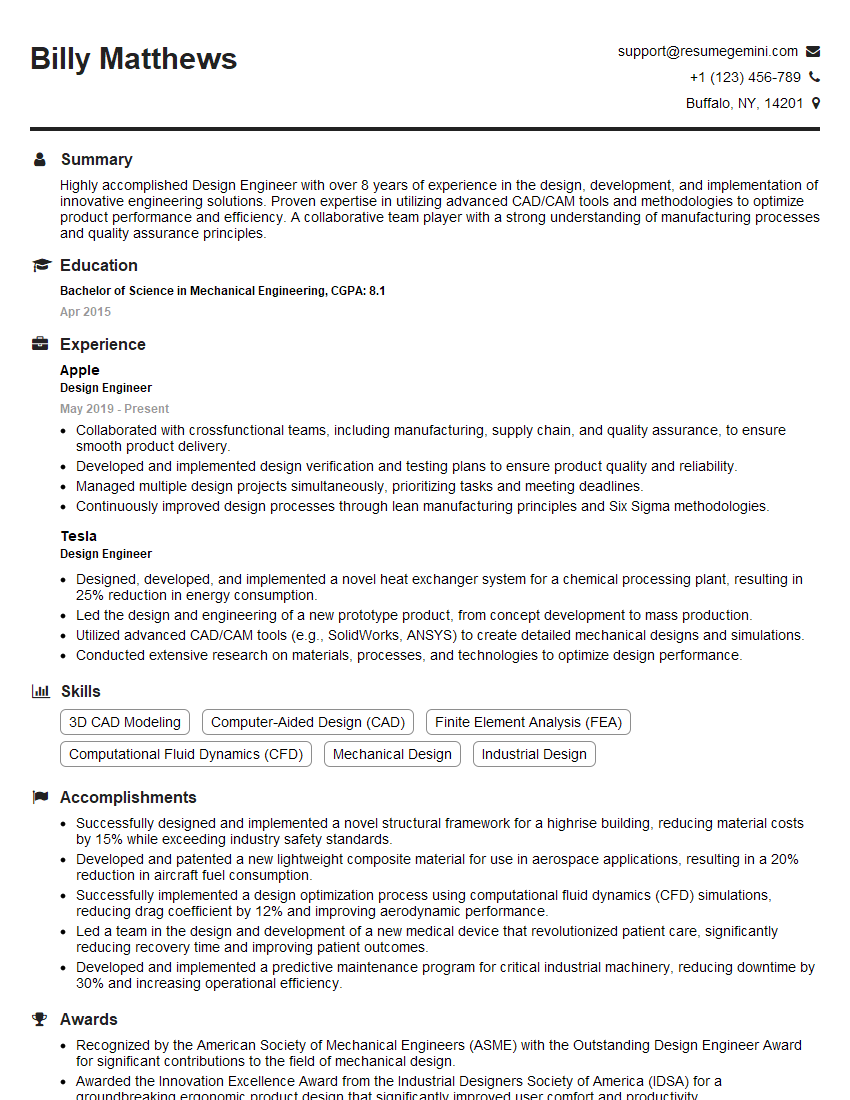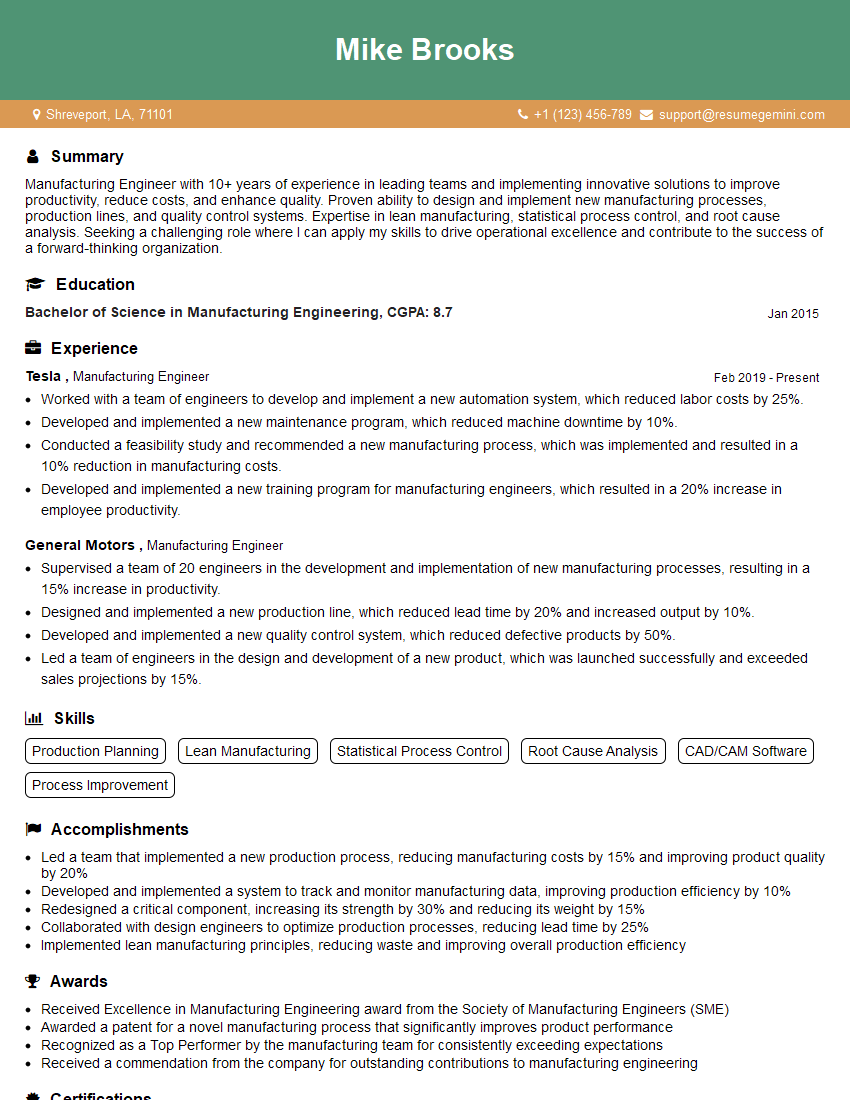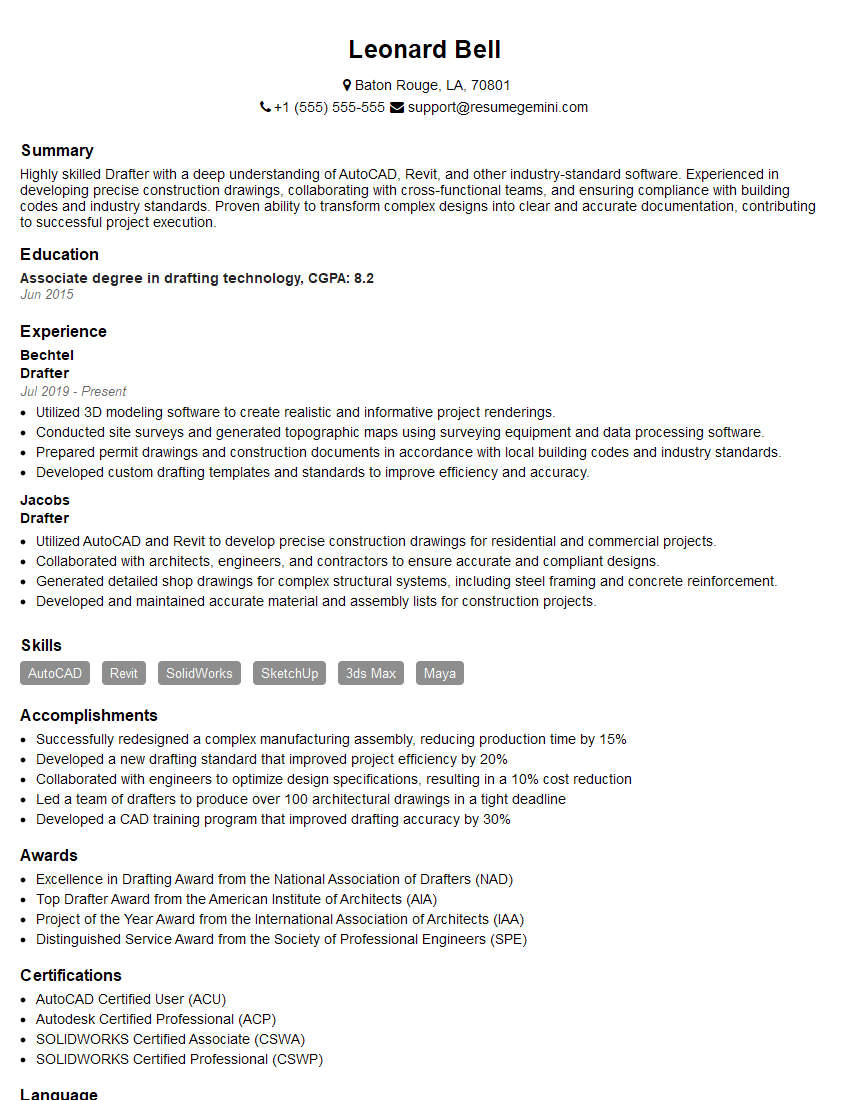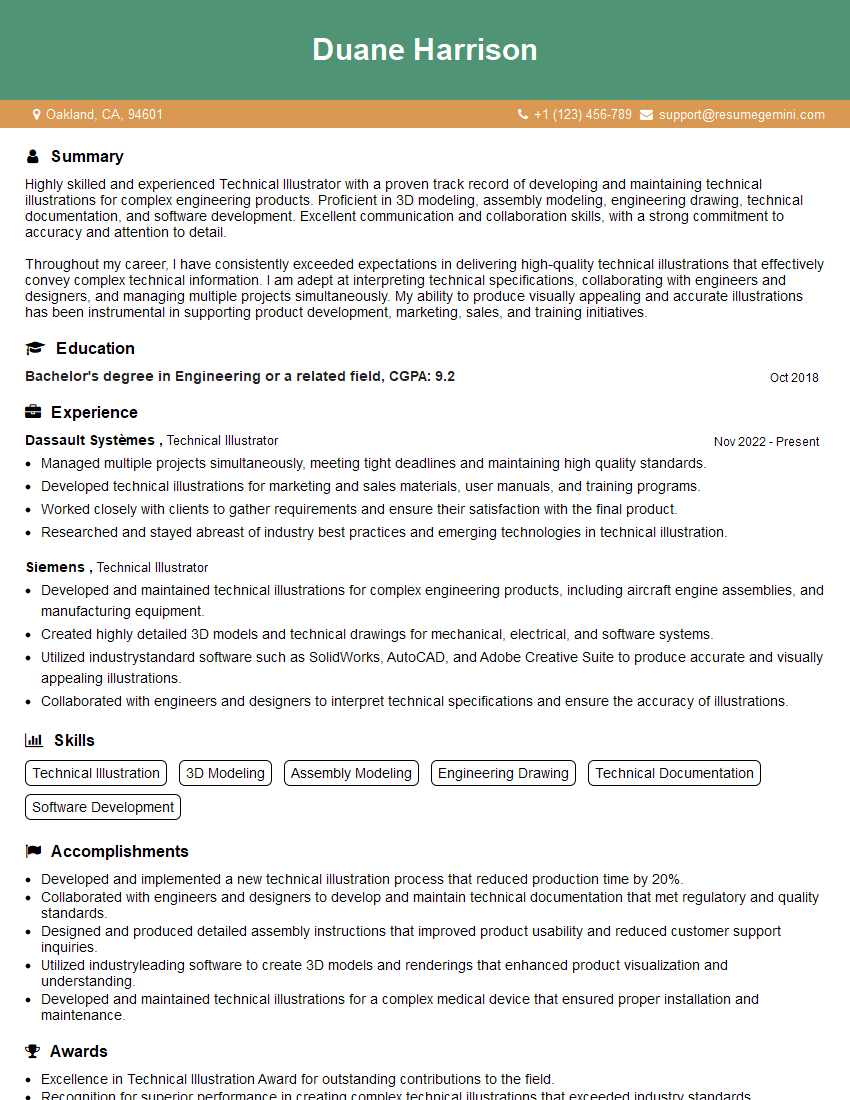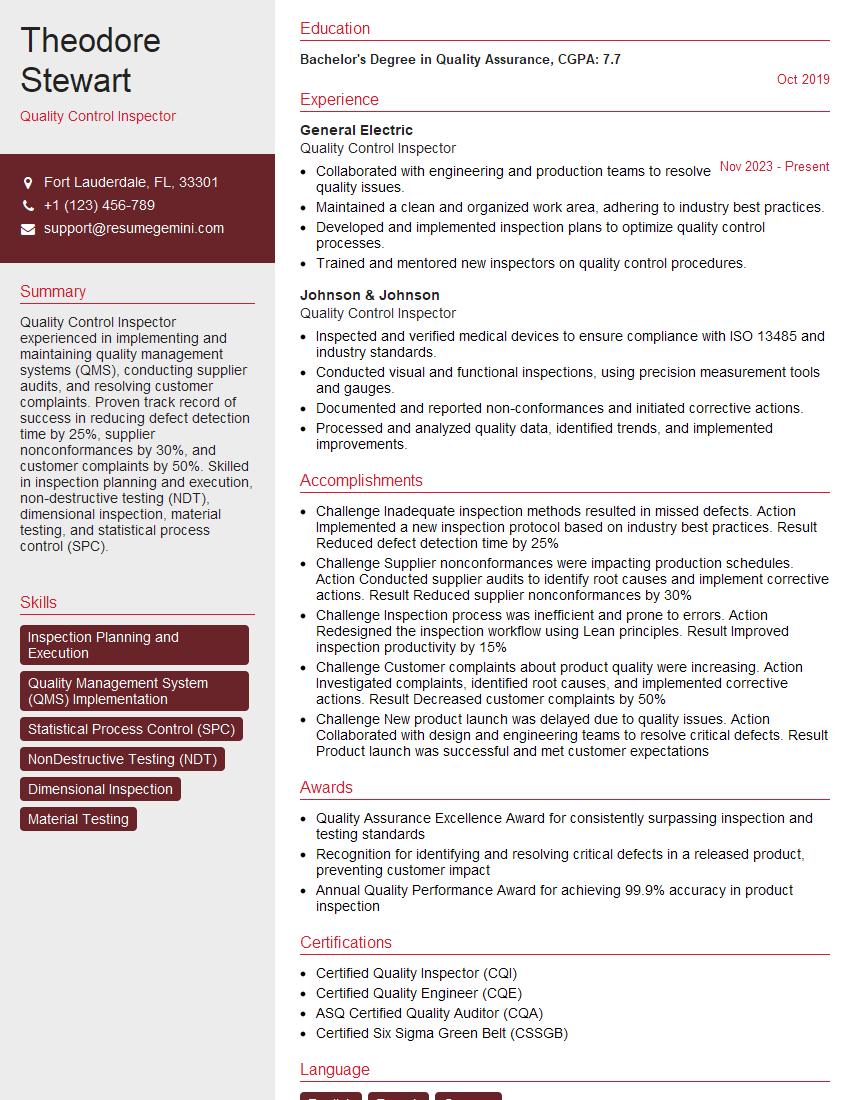Are you ready to stand out in your next interview? Understanding and preparing for Ability to Read and Interpret Specifications interview questions is a game-changer. In this blog, we’ve compiled key questions and expert advice to help you showcase your skills with confidence and precision. Let’s get started on your journey to acing the interview.
Questions Asked in Ability to Read and Interpret Specifications Interview
Q 1. Explain your process for reviewing technical specifications.
My process for reviewing technical specifications is methodical and thorough, ensuring complete understanding and identification of potential issues early on. It involves several key steps:
- Initial Overview: I begin with a high-level read-through to grasp the overall scope, objectives, and key requirements. This provides context for deeper analysis.
- Detailed Examination: Next, I meticulously examine each section, paying close attention to details like units of measurement, tolerances, interfaces, and dependencies. I often use a highlighter and make notes directly on the document.
- Cross-Referencing: I meticulously cross-reference different sections of the specification to identify potential inconsistencies or conflicts between requirements. For example, one section might specify a material, while another implies a different, incompatible one.
- Verification of Feasibility: I assess the practicality and feasibility of the specified requirements. Are the tolerances achievable? Is the proposed technology readily available? Are there any potential design limitations?
- Documentation: Finally, I document all findings, including ambiguities, inconsistencies, and potential issues, with clear explanations and suggested solutions. I typically create a separate document outlining these findings and recommendations.
This structured approach helps ensure a thorough review and minimizes the risk of misinterpretations or overlooking critical details.
Q 2. How do you identify ambiguities or inconsistencies in specifications?
Identifying ambiguities and inconsistencies requires a keen eye for detail and a thorough understanding of the system being specified. I look for several key indicators:
- Conflicting Requirements: This is where one part of the specification contradicts another. For example, one section might specify a maximum weight while another implies a design that exceeds it.
- Vague or Unclear Language: Terms like “approximately,” “suitable,” or “as needed” can lead to ambiguity. I try to replace these with specific quantifiable metrics wherever possible.
- Missing Information: Gaps in the specifications are common. A missing tolerance, an undefined interface, or an unspecified material can all create problems later on.
- Inconsistent Units: Mixing units (e.g., using both millimeters and inches) is a frequent source of error and must be resolved.
- Missing Diagrams or Drawings: Often, a diagram or drawing clarifies a complex description. The absence of visuals can contribute to ambiguity.
I use a combination of careful reading, cross-referencing, and asking clarifying questions to pinpoint these issues. A well-structured specification with clear diagrams and defined terminology reduces the likelihood of these problems.
Q 3. Describe a situation where you had to clarify a specification with the design team.
In a recent project involving the development of a robotic arm, the specifications outlined a particular motor with a specific torque rating. However, the CAD drawings indicated a much smaller mounting space than the motor’s actual dimensions. This was a clear inconsistency. To clarify, I scheduled a meeting with the design team. I presented my findings, including the conflicting information from the specification and the CAD drawings, and clearly explained the potential implications if the motor couldn’t be accommodated. We collectively reviewed the specifications, revisited the design constraints, and ultimately decided to explore alternative, smaller motors that met the torque requirement while fitting within the available space. This collaborative approach ensured a feasible and robust design.
Q 4. How do you prioritize conflicting requirements within a specification?
Prioritizing conflicting requirements involves careful consideration of several factors. It’s not always a simple matter of choosing one over the other. Here’s my approach:
- Understand the Impact: Assess the consequences of satisfying each requirement, and what trade-offs would need to be made. Consider the technical, cost, and schedule implications.
- Identify Root Cause: Often, conflicting requirements stem from miscommunication or incomplete understanding. Investigate the origin of the conflict to inform the prioritization.
- Consult Stakeholders: Collaborate with relevant stakeholders (engineers, designers, project managers, clients) to gain consensus and make an informed decision. This may involve presenting different scenarios and their respective trade-offs.
- Document the Decision: Once a prioritization decision is made, document it clearly, explaining the rationale and any associated risks or trade-offs. This establishes a clear record for future reference.
The prioritization process often involves compromises. Finding the optimal balance requires collaboration and a thorough understanding of the project’s goals and constraints.
Q 5. How do you handle incomplete or unclear specifications?
Handling incomplete or unclear specifications is crucial to avoid costly rework and delays. My approach involves:
- Identify the Gaps: Thoroughly document all missing or unclear information, specifying the nature of the incompleteness (e.g., missing tolerance, undefined interface).
- Seek Clarification: Proactively engage with the design team or the client to request clarifications and additional information. Clearly articulate the impact of the missing information on the design or implementation.
- Make Reasonable Assumptions (with Documentation): If clarification is not immediately available, I may make reasonable assumptions, clearly documenting these assumptions and their potential impact. This ensures transparency and allows for easy modification if the assumptions prove to be incorrect.
- Use Placeholder Values (with Caveats): For numerical values, I might use placeholder values (e.g., “TBD” or a reasonable estimate) with clear warnings that these are subject to change.
- Risk Assessment: Assess the risks associated with the incomplete information and develop mitigation strategies to address potential problems.
It’s important to always document every assumption and decision, emphasizing the provisional nature of work based on incomplete data.
Q 6. Explain your approach to verifying the accuracy of specifications.
Verifying the accuracy of specifications is a continuous process. I employ several techniques:
- Cross-Checking with Other Documents: Compare the specifications against other related documents such as design drawings, test plans, and previous versions of the specifications to identify inconsistencies or discrepancies.
- Unit Consistency Check: Verify the consistent use of units of measurement throughout the document. Inconsistent units are a frequent source of errors.
- Feasibility Analysis: Assess the feasibility of the specified requirements. Are the tolerances achievable? Are the proposed materials readily available?
- Simulation and Modeling: Use simulations or models, where applicable, to verify the behavior of the system under specified conditions.
- Peer Review: Seek feedback from colleagues experienced in similar projects to identify potential oversights or ambiguities.
The goal is to identify and correct errors early in the development process, reducing the likelihood of costly rework or project delays later.
Q 7. Describe your experience using different types of specification documents (e.g., CAD drawings, written documents).
I have extensive experience using various specification documents including CAD drawings (SolidWorks, AutoCAD), written documents (requirements specifications, design documents), and data sheets for components. My ability to interpret these different formats is crucial. For example, when working with CAD drawings, I pay close attention to dimensions, tolerances, and material specifications. I can identify potential clashes and manufacturing issues by carefully reviewing the drawings. For written specifications, I rely on my meticulous reading and critical analysis skills to identify inconsistencies and ambiguities. Understanding the strengths and limitations of each document type allows me to effectively gather the necessary information to complete my tasks.
In essence, my experience spans across various formats and I’m adept at extracting relevant information from each to assemble a complete understanding of project requirements.
Q 8. How do you ensure compliance with specifications throughout a project?
Ensuring compliance with specifications is paramount for project success. It’s a multi-faceted process that begins with a thorough understanding of the specifications themselves. This involves not just reading the document, but actively interpreting its intent, identifying potential ambiguities, and anticipating challenges.
- Baseline Review: At the project’s outset, I conduct a comprehensive review of all specifications, creating a detailed checklist of requirements and deliverables. This checklist serves as a living document, updated as the project progresses.
- Regular Checks: Throughout the project lifecycle, I perform regular checks against the specifications. This involves comparing actual work performed with the specified requirements, using the checklist as a guide. This can involve reviewing designs, code, test results, and any other relevant documentation.
- Version Control: Utilizing version control systems (like Git) for specifications and deliverables is essential. This allows for tracking changes, reverting to previous versions if needed, and ensures everyone works with the most up-to-date information.
- Traceability Matrix: Creating a traceability matrix is crucial. This matrix links requirements to design elements, code modules, test cases, and ultimately, the final product, demonstrating a clear path from specification to implementation.
- Formal Reviews and Audits: Regular formal reviews and audits, involving multiple team members and stakeholders, ensure consistent adherence to the specifications. This proactive approach identifies potential issues early on.
Think of it like building a house: the specifications are the blueprints. Regularly checking your work against the blueprints prevents deviations and ensures the house is built as intended. Ignoring the blueprints can lead to costly rework and potentially unsafe structures.
Q 9. How do you communicate specification changes to relevant stakeholders?
Communicating specification changes effectively is critical to maintain project alignment. My approach involves a structured, multi-step process.
- Formal Change Request Process: Any proposed change must go through a formal change request process, documented and approved by relevant stakeholders. This includes clearly outlining the rationale, impact assessment (cost, schedule, scope), and proposed solutions.
- Clear and Concise Communication: When a change is approved, I communicate it clearly and concisely to the affected teams using appropriate channels (e.g., email, project management software, team meetings). This communication includes details of the change, its impact, and the deadline for implementation.
- Version Control and Updates: All specification documents are updated to reflect the approved changes. Version control helps track changes and ensures everyone is working with the latest version.
- Training and Support: For significant changes, I provide training and support to ensure the teams understand and can implement the updated specifications effectively.
- Impact Monitoring: Post-change implementation, I monitor for any unforeseen issues resulting from the changes and take necessary corrective actions.
Imagine announcing a change in flight plans mid-flight. Clear and structured communication is as crucial for successful project completion as it is for a safe flight.
Q 10. How familiar are you with industry-standard specification formats?
I’m proficient with various industry-standard specification formats, including:
- IEEE 830 (Recommended Practice for Software Requirements Specifications): This standard provides a framework for documenting software requirements. I’m adept at creating and interpreting documents adhering to this standard.
- UML (Unified Modeling Language): I use UML diagrams, like use case diagrams and class diagrams, for visualizing and communicating system requirements.
- XML (Extensible Markup Language): I’m experienced in working with XML-based specifications, often used for data exchange and configuration.
- JSON (JavaScript Object Notation): Similarly, I have hands-on experience with JSON-based specifications, frequently used in web and mobile application development.
- Custom formats: I am also comfortable working with organization-specific or project-specific formats, adapting my approach to meet the specific needs.
Understanding these diverse formats ensures seamless integration with various development processes and tools.
Q 11. Have you ever had to adapt specifications due to unforeseen circumstances?
Yes, I have encountered situations where unforeseen circumstances necessitated adapting specifications. One example involved a project developing a mobile application where a significant change in the target operating system’s API required adapting our original specifications.
- Impact Assessment: First, we performed a thorough impact assessment to determine the extent of the changes needed.
- Collaboration and Communication: We collaborated closely with the development team, testing team, and stakeholders to discuss solutions and agree on changes to the specifications.
- Prioritization: We prioritized changes based on their impact and feasibility, focusing on critical features first.
- Documentation: All changes were documented clearly, along with the rationale behind them, to maintain transparency.
- Testing and Validation: Rigorous testing was performed to ensure the application still met its core functionalities despite the modifications.
Adaptability is key in a dynamic environment. Successfully navigating these circumstances demonstrates problem-solving skills and a commitment to delivering a successful project, even with unexpected challenges.
Q 12. Describe a time you identified a critical error in a specification.
During a project involving the development of a complex embedded system, I identified a critical omission in the specifications related to power management. The specifications adequately addressed functionality but lacked critical details on power consumption limits and battery life requirements.
- Immediate Action: I immediately flagged this omission to the project manager and stakeholders.
- Impact Analysis: We conducted a thorough analysis to determine the potential impact of this oversight. It could have resulted in significant problems such as premature battery drain or system instability.
- Proposed Solution: I proposed a solution involving adding detailed power management specifications, including power consumption targets for various operating modes and testing procedures to ensure compliance.
- Collaborative Resolution: We collaboratively worked with the hardware engineers to resolve this issue by incorporating the necessary changes into the updated specifications.
- Lessons Learned: This experience emphasized the importance of thorough specification reviews, paying close attention to potential omissions and the need for cross-functional collaboration to resolve inconsistencies.
This situation highlighted the value of proactive problem-solving, preventing potential costly and time-consuming issues later in the development cycle.
Q 13. How do you use specifications to estimate project costs and timelines?
Specifications are the foundation for accurate project cost and timeline estimations. They provide a detailed breakdown of requirements, which forms the basis for resource allocation and task scheduling.
- Work Breakdown Structure (WBS): I use the specifications to create a detailed WBS, breaking down the project into smaller, manageable tasks.
- Effort Estimation: Each task is assigned an estimated effort based on its complexity and the specified requirements. This might involve using techniques like story points or function point analysis.
- Resource Allocation: Based on effort estimations, I allocate necessary resources, including personnel, equipment, and software.
- Cost Estimation: The estimated effort and resource allocation are translated into a cost estimate, accounting for labor costs, material costs, and other project expenses.
- Timeline Estimation: The WBS and effort estimations are used to create a project timeline, identifying dependencies between tasks and setting realistic deadlines.
Imagine planning a road trip. The specifications are your itinerary: they detail your destination, planned stops, and necessary resources. Without a clear itinerary (specifications), you risk running out of fuel (budget) or missing your destination (deadlines).
Q 14. What tools or software do you use to manage and interpret specifications?
I utilize several tools and software for managing and interpreting specifications, depending on the project’s context and complexity.
- Requirements Management Tools (e.g., Jama Software, Polarion): These tools allow for centralized management of specifications, tracking changes, and managing traceability.
- Version Control Systems (e.g., Git): Essential for managing different versions of specifications and ensuring collaboration among team members.
- Modeling Tools (e.g., Enterprise Architect, Lucidchart): Used for creating visual representations of system requirements, such as UML diagrams.
- Spreadsheet Software (e.g., Microsoft Excel, Google Sheets): Useful for creating traceability matrices and organizing requirements data.
- Project Management Software (e.g., Jira, Asana): For integrating specifications into the overall project management workflow.
The choice of tools depends on the project’s scale and the organization’s specific needs. However, the overarching goal is to streamline the process and ensure everyone has access to the most up-to-date and accurate information.
Q 15. Describe your experience working with different specification versions and revisions.
Working with evolving specifications is commonplace in engineering and design. My experience spans various versions and revisions, often managed through version control systems like Git or document management systems. I’ve handled situations where specifications underwent minor updates (e.g., clarifying a single sentence), major overhauls (e.g., changing the entire design approach), and even completely superseded documents. I meticulously track these changes using a combination of version numbering (e.g., v1.0, v1.1, v2.0), change logs detailing modifications, and date stamps. For example, in a recent project involving the design of a medical device, the initial specifications (v1.0) focused primarily on functionality. Subsequent revisions (v1.1, v1.2) incorporated stricter regulatory compliance requirements and material specifications, each change carefully documented and version-controlled. This meticulous approach ensures traceability and minimizes confusion.
Career Expert Tips:
- Ace those interviews! Prepare effectively by reviewing the Top 50 Most Common Interview Questions on ResumeGemini.
- Navigate your job search with confidence! Explore a wide range of Career Tips on ResumeGemini. Learn about common challenges and recommendations to overcome them.
- Craft the perfect resume! Master the Art of Resume Writing with ResumeGemini’s guide. Showcase your unique qualifications and achievements effectively.
- Don’t miss out on holiday savings! Build your dream resume with ResumeGemini’s ATS optimized templates.
Q 16. How do you track changes made to specifications?
Tracking changes to specifications requires a systematic approach. I primarily leverage version control systems (like Git) or dedicated document management systems (like Sharepoint or Confluence). These systems automatically record changes, allowing for easy comparison between revisions. Beyond the software, I also maintain a detailed change log documenting the purpose and impact of each modification. This log typically includes the date, author, description of changes, and justification. For instance, if a tolerance specification is altered, the change log would clearly explain the reason for the adjustment—perhaps due to improved manufacturing capabilities or a tighter regulatory requirement. This dual approach—system-based version control and a meticulous change log—ensures complete and auditable tracking of specification modifications.
Q 17. How do you determine the criticality of a specification requirement?
Determining the criticality of a specification requirement involves a risk-based assessment. I consider several factors: the potential impact of non-compliance (e.g., safety hazards, functional failure, cost overruns), the feasibility of meeting the requirement, and the regulatory context. For example, in a safety-critical system, requirements related to fail-safe mechanisms would be classified as extremely critical. Conversely, a minor cosmetic detail might be considered low criticality. I often use a formal risk assessment matrix to categorize requirements by severity and probability of failure, which then informs prioritization and resource allocation during the design and manufacturing process. A clear understanding of criticality guides testing, verification, and validation efforts, ensuring that the most crucial aspects are given the appropriate attention.
Q 18. What is your approach to resolving discrepancies between different specifications?
Resolving discrepancies between different specifications necessitates a structured approach. First, I identify the conflicting requirements and their sources. Then, I analyze each specification to determine its authority and relevance. Often, one specification will supersede another based on date, version, or organizational hierarchy. In cases where the conflict remains unresolved, I initiate a collaborative process involving stakeholders (design engineers, manufacturing, regulatory affairs) to determine the best course of action. This often involves documenting the conflict, proposing solutions, and reaching a consensus. Sometimes, it necessitates revisiting the underlying design or requirements to eliminate the contradiction. Thorough documentation of the resolution is critical for transparency and future reference.
Q 19. How do you ensure all specifications are correctly understood by your team?
Ensuring team understanding of specifications involves a multi-pronged strategy. First, I ensure the specifications are clearly written and readily accessible to everyone. Second, I conduct thorough specification reviews with the team, explaining key requirements, addressing ambiguities, and encouraging questions. Third, I utilize training materials, visual aids (diagrams, flowcharts), and interactive sessions to enhance comprehension. Fourth, I employ regular communication channels to address any emerging questions or concerns. In certain cases, creating a simple Q&A document or FAQ section can be extremely valuable for the entire team. Finally, I incorporate specification-related questions into testing and design review processes to reinforce understanding and identify any gaps in knowledge.
Q 20. Describe your experience using tolerance specifications.
Tolerance specifications define the permissible variation in a dimension or characteristic. My experience encompasses various tolerance types (e.g., bilateral, unilateral, geometric) and their application in different contexts. I understand the importance of selecting appropriate tolerance levels based on functional requirements, manufacturing capabilities, and cost considerations. For instance, specifying overly tight tolerances may increase manufacturing costs and lead to delays, while overly loose tolerances might compromise functionality. I regularly work with Geometric Dimensioning and Tolerancing (GD&T) standards to clearly and unambiguously communicate tolerance requirements, reducing ambiguity and preventing misinterpretations. In one instance, proper understanding of GD&T helped avoid costly rework by ensuring that manufacturing followed a clear, unambiguous set of specifications.
Q 21. How do you handle conflicting specifications from different sources?
Handling conflicting specifications from different sources requires careful consideration and a hierarchical approach. First, I identify the source of each specification and establish a priority order based on factors like authority, date, and relevance. For example, a company internal specification might override a general industry standard if there are specific requirements that necessitate it. If the conflict cannot be resolved through a simple hierarchical approach, I escalate it to the appropriate stakeholders (project managers, engineering leads, management) to reach a consensus. Open communication and collaboration are key to resolving these conflicts efficiently. Comprehensive documentation of the decision-making process is essential for future reference and avoids repeating the same conflict.
Q 22. Explain the difference between functional and non-functional specifications.
Functional specifications define what a system or product should do, outlining its features and functionalities. Think of them as the ‘what’ – they describe the behavior and capabilities from a user’s perspective. Non-functional specifications, on the other hand, define how a system or product should perform. These are the ‘how’ – they describe qualities like performance, security, scalability, and usability.
- Functional Example: A software specification might state, “The system shall allow users to upload images.” This describes a specific function.
- Non-Functional Example: The same specification might also state, “The system shall have a response time of under 2 seconds for image uploads.” This describes a performance requirement.
In essence, functional specs focus on functionality, while non-functional specs focus on quality attributes. They are both crucial for a successful project; a system can have all the right features (functional) but fail if it’s too slow or insecure (non-functional).
Q 23. How do you interpret and implement dimensional specifications?
Interpreting and implementing dimensional specifications requires careful attention to detail and a strong understanding of geometric dimensioning and tolerancing (GD&T). This involves understanding not only the nominal size but also the allowable variations. For example, a dimension might be specified as “10mm ± 0.1mm.” This means the actual dimension can be anywhere between 9.9mm and 10.1mm and still be considered acceptable.
Implementation involves using precision measuring tools like calipers, micrometers, and coordinate measuring machines (CMMs) to verify that the manufactured part falls within the specified tolerances. GD&T symbols further refine these tolerances, specifying things like perpendicularity, flatness, and roundness. These symbols are crucial for ensuring proper part fit and function.
Example: Consider a shaft that needs to fit into a hole. The specification might include GD&T symbols to define the allowable variations in shaft diameter and hole diameter, as well as their concentricity and straightness. Ignoring these tolerances could result in a poor fit, leading to malfunction or failure.
Q 24. How familiar are you with material specifications and standards?
I’m very familiar with material specifications and standards. My experience includes working with various materials, from metals and plastics to composites and ceramics. I understand the importance of specifying material properties like tensile strength, yield strength, ductility, hardness, and chemical composition. I am proficient in interpreting material specifications from sources such as ASTM (American Society for Testing and Materials), ISO (International Organization for Standardization), and industry-specific standards.
Understanding material specifications is crucial for ensuring that a product meets its performance requirements and complies with safety regulations. Choosing the wrong material or failing to properly specify its properties can lead to product failure or even catastrophic consequences.
Example: In specifying a material for a pressure vessel, I would carefully consider factors like yield strength, corrosion resistance, and weldability to ensure that the vessel can withstand the intended pressure without failure.
Q 25. Describe your experience with reviewing and analyzing technical drawings.
I have extensive experience reviewing and analyzing technical drawings, including blueprints, schematics, and assembly drawings. My process involves systematically checking for completeness, accuracy, and compliance with specifications. This includes verifying dimensions, tolerances, material specifications, and manufacturing processes depicted in the drawings. I’m adept at using CAD software to review and annotate drawings, and I am familiar with various drawing standards like ASME Y14.5.
I regularly identify potential design flaws or inconsistencies during this review process, proposing improvements or clarifications to ensure the drawings accurately reflect the design intent. This proactive approach helps prevent costly errors during manufacturing and assembly.
Example: In one project, I identified a missing detail on an assembly drawing that could have resulted in an incorrect part installation. By catching this early, we avoided a significant rework effort.
Q 26. How do you ensure that your interpretation of specifications is accurate and complete?
Ensuring accurate and complete interpretation of specifications is a multi-step process. First, I carefully review all relevant documentation, including the specifications themselves, any supporting documents, and previous revisions. I then clarify any ambiguities by contacting the original specifiers or relevant stakeholders. This may involve meetings, emails, or even on-site inspections.
Next, I use cross-referencing techniques to ensure consistency between different sections of the specifications and between the specifications and other project documents. I pay close attention to units of measurement, terminology, and any potential conflicts or contradictions. Finally, I document my interpretation, including any assumptions or clarifications made, so that the entire process is auditable and transparent.
Q 27. How do you balance the need for precise adherence to specifications with the practical realities of project execution?
Balancing precise adherence to specifications with practical realities is a key challenge in engineering. While exact adherence is ideal, it’s often not feasible or cost-effective. This requires a pragmatic approach that involves understanding the implications of deviations from the specifications. This includes assessing the impact of tolerances, substitutions of materials, or changes in manufacturing processes.
When deviations are necessary, I document them thoroughly, including the reasons for the deviation, the proposed alternative, and an assessment of its impact on performance and safety. This requires strong communication and collaboration with the design team, manufacturing team, and any relevant regulatory bodies to ensure that the changes are acceptable and properly documented.
Example: If a specified material is unavailable, I would explore suitable alternatives, ensuring that they meet the critical performance requirements while documenting the rationale for the change and obtaining necessary approvals.
Q 28. Describe a time you successfully used specifications to troubleshoot a technical problem.
During a project involving the assembly of a complex electromechanical system, we encountered a recurring malfunction. The system would intermittently shut down, and initial troubleshooting efforts were inconclusive. By carefully reviewing the system specifications, particularly the timing diagrams and power supply requirements, I identified a critical timing constraint that was being violated due to a slight variation in the components’ response times. The specifications clearly defined acceptable tolerances, but the actual component variations exceeded them.
Using the specifications as a guide, we were able to pinpoint the source of the problem – a slight delay in one specific component’s signal. We then implemented a software-based delay compensation algorithm to address this issue. The problem was resolved, and the system operated reliably, highlighting the importance of thoroughly understanding and referring to specifications during troubleshooting.
Key Topics to Learn for Ability to Read and Interpret Specifications Interview
- Understanding Technical Language: Mastering the terminology and jargon specific to the industry and role. This includes understanding acronyms, technical terms, and industry-specific vocabulary.
- Identifying Key Requirements: Developing skills in quickly identifying the core functionalities, constraints, and deliverables outlined in the specifications. Practice extracting essential information from dense technical documents.
- Interpreting Diagrams and Visuals: Becoming proficient in interpreting flowcharts, diagrams, schematics, and other visual representations of system specifications. Understand how these visuals support the written text.
- Analyzing and Deconstructing Specifications: Breaking down complex specifications into manageable parts to identify dependencies, potential conflicts, and areas needing clarification.
- Problem-Solving & Critical Thinking: Applying critical thinking to identify potential problems, ambiguities, or gaps in the provided specifications. Demonstrate your ability to propose solutions and ask clarifying questions.
- Prioritization and Planning: Practicing the skill of prioritizing tasks and creating a logical plan of action based on the specifications’ requirements and constraints.
- Communication and Collaboration: Understanding how to effectively communicate your interpretation of the specifications to colleagues and stakeholders. Practice explaining technical concepts clearly and concisely.
- Version Control and Documentation: Understanding the importance of working with different versions of specifications and maintaining clear documentation of your interpretation and problem-solving process.
Next Steps
Mastering the ability to read and interpret specifications is crucial for career advancement in any technical field. It demonstrates your attention to detail, problem-solving skills, and ability to translate complex information into actionable plans. To increase your chances of landing your dream role, focus on building an ATS-friendly resume that highlights these crucial skills. ResumeGemini is a trusted resource to help you craft a professional and impactful resume that showcases your abilities effectively. Examples of resumes tailored to highlight proficiency in reading and interpreting specifications are provided to further assist you.
Explore more articles
Users Rating of Our Blogs
Share Your Experience
We value your feedback! Please rate our content and share your thoughts (optional).
What Readers Say About Our Blog
This was kind of a unique content I found around the specialized skills. Very helpful questions and good detailed answers.
Very Helpful blog, thank you Interviewgemini team.
